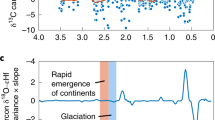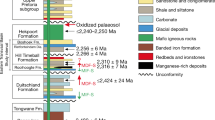Abstract
Arising from M. T. Rosing, D. K. Bird, N. H. Sleep & C. J. Bjerrum Nature 464, 744–747 (2010)10.1038/nature08955
The solar luminosity during the Archean (3.8 to 2.5 billion years ago) was 20–25% lower than at present, and was probably compensated, at least in part, by a stronger greenhouse effect1,2,3. Rosing et al.4 estimate the Archean partial pressure of carbon dioxide to have been about  ≈ 10−3 bar, on the basis of the simultaneous occurrence of magnetite (Fe3O4) and siderite (FeCO3) in banded iron formations (BIFs, a type of chemical sediment). Here, we question a central assumption by Rosing et al.4 that the mineralogy of BIFs reflects near-thermodynamic equilibrium with the atmosphere–ocean system; just as the presence of authigenic pyrite in modern sediments does not imply that the modern atmosphere is anoxic, the mineralogy of BIFs cannot be used to argue for a low-
≈ 10−3 bar, on the basis of the simultaneous occurrence of magnetite (Fe3O4) and siderite (FeCO3) in banded iron formations (BIFs, a type of chemical sediment). Here, we question a central assumption by Rosing et al.4 that the mineralogy of BIFs reflects near-thermodynamic equilibrium with the atmosphere–ocean system; just as the presence of authigenic pyrite in modern sediments does not imply that the modern atmosphere is anoxic, the mineralogy of BIFs cannot be used to argue for a low- Archean atmosphere. Carbon dioxide is therefore still a viable greenhouse gas candidate with which to explain the warm Archean climate.
Archean atmosphere. Carbon dioxide is therefore still a viable greenhouse gas candidate with which to explain the warm Archean climate.
Similar content being viewed by others
Main
The original iron precipitate in the BIFs was probably ferrihydrite, Fe2O3·xH2O. The ferrihydrite was precipitated out of equilibrium with the atmosphere by oxidation of upwelled ferrous iron, either by O2 produced by cyanobacteria within the water column or by phototrophic, anoxygenic, iron-oxidizing bacteria. Once in the sediment, ferrihydrite was subsequently converted to a stable iron oxide, either magnetite or haematite, or to the reduced mineral siderite. The constraint on  –
– derives from applying the following equilibrium reaction between magnetite and siderite:
derives from applying the following equilibrium reaction between magnetite and siderite:  . As discussed below,
. As discussed below,  is a measure of the redox potential of the system, but organic matter (CH2O) was the reducing agent in this reaction.
is a measure of the redox potential of the system, but organic matter (CH2O) was the reducing agent in this reaction.
In the model of Rosing et al.4,  was controlled by methanogens. Anaerobic ecosystems of this nature have been studied by ref. 5. The downward flux of H2 through the atmosphere–ocean interface is limited by its piston velocity to (1–6) × 1011 molecules cm−2 s−1 (Table 2 in ref. 5). The average deposition rate of Fe3O4 in BIFs is estimated to be 0.1–1 mm yr−1, or (40–400) × 1011 molecules cm−2 s−1, assuming that each microband represents one year of deposition6. Suggestions that the deposition rate was much slower than this7,8 are probably biased by hiatuses in the geologic record. Reducing this iron to siderite would require an equal flux of H2, which is 7–400 times the downward H2 flux into the ocean estimated above. Some H2 could have been produced within the sediment via fermentation, but this requires that organic matter be available. Formation of siderite without a reducing agent—that is, by disproportionation (
was controlled by methanogens. Anaerobic ecosystems of this nature have been studied by ref. 5. The downward flux of H2 through the atmosphere–ocean interface is limited by its piston velocity to (1–6) × 1011 molecules cm−2 s−1 (Table 2 in ref. 5). The average deposition rate of Fe3O4 in BIFs is estimated to be 0.1–1 mm yr−1, or (40–400) × 1011 molecules cm−2 s−1, assuming that each microband represents one year of deposition6. Suggestions that the deposition rate was much slower than this7,8 are probably biased by hiatuses in the geologic record. Reducing this iron to siderite would require an equal flux of H2, which is 7–400 times the downward H2 flux into the ocean estimated above. Some H2 could have been produced within the sediment via fermentation, but this requires that organic matter be available. Formation of siderite without a reducing agent—that is, by disproportionation ( )—would require an effective
)—would require an effective  of 3 × 10−6 (the value at the magnetite–haematite boundary), which is ten times smaller than the value that Rosing et al.4 propose and is probably impossible to achieve.
of 3 × 10−6 (the value at the magnetite–haematite boundary), which is ten times smaller than the value that Rosing et al.4 propose and is probably impossible to achieve.
Probably the reducing agent was not H2 but organic matter produced by photosynthesis in the water column. A fraction of the primary production of organic matter was exported from the photic zone to the sediment, where microbial iron respiration could produce siderite9,10,11,12:  . Light carbon isotope ratios are found in siderite, but not in associated Ca/Mg carbonates11,12,13, indicating that a portion of the carbon in siderite was indeed derived from a pool of isotopically light organic matter. In BIFs, magnetite was initially in disequilibrium with the overlying CO2-rich atmosphere and was converted to siderite. However, the above reaction was only allowed to proceed as long as a reductant (organic matter) was available. The rain of organic carbon into the sediment was not sufficient to keep pace with that of Fe3+-bearing oxide, and its exhaustion led to a mineral assemblage (coexisting magnetite and siderite) that did not reflect equilibrium conditions with the atmosphere–ocean system. The transition from siderite to iron oxides in BIFs from the Campbellrand–Kuruman complex could have been caused by the decreased supply of organic material in offshore regions10.
. Light carbon isotope ratios are found in siderite, but not in associated Ca/Mg carbonates11,12,13, indicating that a portion of the carbon in siderite was indeed derived from a pool of isotopically light organic matter. In BIFs, magnetite was initially in disequilibrium with the overlying CO2-rich atmosphere and was converted to siderite. However, the above reaction was only allowed to proceed as long as a reductant (organic matter) was available. The rain of organic carbon into the sediment was not sufficient to keep pace with that of Fe3+-bearing oxide, and its exhaustion led to a mineral assemblage (coexisting magnetite and siderite) that did not reflect equilibrium conditions with the atmosphere–ocean system. The transition from siderite to iron oxides in BIFs from the Campbellrand–Kuruman complex could have been caused by the decreased supply of organic material in offshore regions10.
To summarize, microbial cycling and diagenesis of organic matter and ferric iron controlled the effective  and
and  in the sediment. The mineralogy of BIFs reflects these conditions, with no simple relationship to atmospheric CO2. Thus,
in the sediment. The mineralogy of BIFs reflects these conditions, with no simple relationship to atmospheric CO2. Thus,  in the atmosphere may have been high enough (about 0.1 bar) to explain the warm Archean climate, without the need for additional warming mechanisms.
in the atmosphere may have been high enough (about 0.1 bar) to explain the warm Archean climate, without the need for additional warming mechanisms.
References
Sagan, C. & Mullen, G. Earth and Mars: evolution of atmospheres and surface temperatures. Science 177, 52–56 (1972)
Owen, T., Cess, R. D. & Ramanathan, V. Enhanced CO2 greenhouse to compensate for reduced solar luminosity on early Earth. Nature 277, 640–642 (1979)
Walker, J. C. G., Hays, P. B. & Kasting, J. F. A negative feedback mechanism for the long-term stabilization of Earth’s surface temperature. J. Geophys. Res. 86, 9776–9782 (1981)
Rosing, M. T., Bird, D. K., Sleep, N. H. & Bjerrum, C. J. No climate paradox under the faint early Sun. Nature 464, 744–747 (2010)
Kharecha, P., Kasting, J. & Siefert, J. A coupled atmosphere-ecosystem model of the early Archean Earth. Geobiology 3, 53–76 (2005)
Konhauser, K. O. et al. Could bacteria have formed the Precambrian banded iron formations? Geology 30, 1079–1082 (2002)
Pickard, A. L. SHRIMP U-Pb zircon ages for the Palaeoproterozoic Kuruman iron formation, Northern Cape Province, South Africa: evidence for simultaneous BIF deposition on Kaapvaal and Pilbara cratons. Precambr. Res. 125, 275–315 (2003)
Trendall, A. F., Compston, W., Nelson, D. R., De Laeter, J. R. & Bennett, V. C. SHRIMP zircon ages constraining the depositional chronology of the Hamersley Group, Western Australia. Aust. J. Earth Sci. 51, 621–644 (2004)
Walker, J. C. G. Suboxic diagenesis in banded iron formations. Nature 309, 340–342 (1984)
Fischer, W. W. & Knoll, A. H. An iron shuttle for deepwater silica in Late Archean and early Paleoproterozoic iron formation. Geol. Soc. Am. Bull. 121, 222–235 (2009)
Heimann, A. et al. Fe, C, and O isotope compositions of banded iron formation carbonates demonstrate a major role for dissimilatory iron reduction in ∼2.5 Ga marine environments. Earth Planet. Sci. Lett. 294, 8–18 (2010)
Craddock, P. R. & Dauphas, N. Iron and carbon isotope evidence for microbial iron respiration throughout the Archean. Earth Planet. Sci. Lett. 303, 121–132 (2011)
Becker, R. H. & Clayton, R. N. Carbon isotopic evidence for the origin of a banded iron-formation in Western Australia. Geochim. Cosmochim. Acta 36, 577–595 (1972)
Author information
Authors and Affiliations
Contributions
Both authors contributed equally to this work.
Corresponding author
Ethics declarations
Competing interests
Competing financial interests: declared none.
Rights and permissions
About this article
Cite this article
Dauphas, N., Kasting, J. Low  in the pore water, not in the Archean air.
Nature 474, E1 (2011). https://doi.org/10.1038/nature09960
in the pore water, not in the Archean air.
Nature 474, E1 (2011). https://doi.org/10.1038/nature09960
Received:
Accepted:
Published:
Issue Date:
DOI: https://doi.org/10.1038/nature09960
This article is cited by
-
Mission to Planet Earth: The First Two Billion Years
Space Science Reviews (2020)
-
Origin and evolution of the atmospheres of early Venus, Earth and Mars
The Astronomy and Astrophysics Review (2018)
-
Biochemical characterization of predicted Precambrian RuBisCO
Nature Communications (2016)
-
Evolutionary Importance of the Intramolecular Pathways of Hydrolysis of Phosphate Ester Mixed Anhydrides with Amino Acids and Peptides
Scientific Reports (2014)
-
Fossil raindrops and ancient air
Nature (2012)
Comments
By submitting a comment you agree to abide by our Terms and Community Guidelines. If you find something abusive or that does not comply with our terms or guidelines please flag it as inappropriate.



